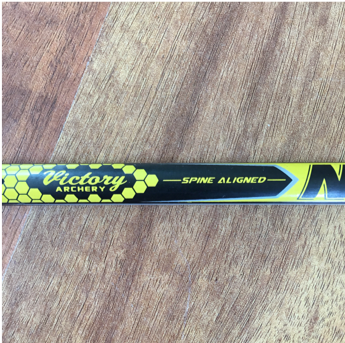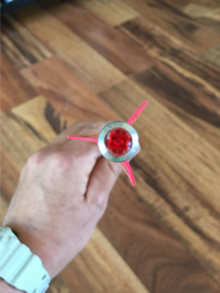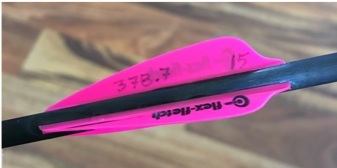NFAA News
Jun 07, 2018
Advanced Arrow Culling

Article by Rod White, NFAA Bowhunting and Event Coordinator. Rod is an Olympic Gold Medalist and Professional Archer. Subscribe to the NFAA Youtube Channel and watch NFAA Talks with Rod White at: https://www.youtube.com/user/NFAAUSA/feed
If you are SERIOUS about competitive shooting, or SERIOUS about the performance and consistency of your hunting arrows, then this article is for you. If you are a casual recreational archer or bowhunter that prefers to purchase arrows pre-fletched and pre-cut, than please read the previous blog. There I mentioned quite a bit that a hunter or target archer can do to ensure consistency in accuracy and repeatability from arrow to arrow that come pre-fletched and pre-cut from a retailer or online store. In this blog, I'm going to cover how to build a dozen arrows from bare shafts to a fully finished dozen with Olympic caliber consistency. If you follow this process, you'll have a full batch of arrows that are ready to compete, or hunt at the highest level possible. Acquiring several tools, and a genuine desire to build this kind of consistency, is something that you must have in order to be successful in the art of arrow building. Any shortcuts that you take will ultimately result in some level of inconsistency. That statement is not meant to discourage you, but rather encourage you to strive for the highest level of perfection possible, with the best equipment possible.
It's important to note throughout this process, that I'm assuming you are shooting carbon arrows. If you're shooting aluminum or wood arrows, your processes may be slightly different. First I'll begin by walking you through the process. Following that, there are some tools and product suggestions in those categories that you can reference as you read through my building process.
All of the advice I put into these blogs and articles is a culmination of learning through experience, picking up bits of information from other pros, and what has been taught to me by several mentors. It's likely that you will have heard some of these things before, and maybe some things you haven't, but this is the most thorough process that I have put together and I hope it helps provide the results you're looking for when building your own arrows.
Advanced Arrow Building
At first glance, this process seems like it may be daunting, but it's really not when compared to the process of culling arrows and making remedies as I mentioned in the last blog. You're still going to go through that process, but the number of errant arrows that show up will be incredibly reduced. Which means the amount of time spent trying to figure out why an arrow won't consistently group with your other arrows, will be cut down to a fraction of the time. Step-by-step, you will eliminate variables that are otherwise hidden in your arrow construction process.
Start by determining your arrow length with the help of a friend or pro shop. I generally strive for my arrow to overhang from the arrow rest anywhere from 1 1/2" to 2 1/2" depending on my desired arrow weight and possibly broadhead design, if I'm building a hunting rig. Then we'll begin by cutting the arrows to length. But before you fire up the saw, you'll need to get out your arrow spinner. Available for less than $30 from most retailers, this device allows you to check the straightness of your arrows across the length of the arrow.

Start by placing your arrow on the spinning wheels as centered up as possible. This doesn't have to be perfect because until your arrow is completely built, we won't know which section of the arrow will be doing most of the flexing, however it's highly likely that it's slightly forward of center. Spin the arrow on the arrow spinner and observe both ends of the arrow. If one end wobbles quite a bit, were going to measure from the end that doesn't wobble, down the shaft to the desired length of your arrow and make a mark. If either end wobbles more than the other, we'll of course want to cut more from that side of the arrow than the side that wobbles less. In a nutshell, we're just trying to get the straightest length of the arrow shaft as possible. It's very common to see less wobble, or less variances in higher grade arrows as opposed to lower grade arrows. Don't concern yourself about where the labels are, they're actually irrelevant on most arrow shafts. There is one major exception to this rule, and that is if you are shooting a barreled shaft such as the Easton X10, A/C/E, or any other shaft that has a tapered design. For those that choose to shoot these arrows, follow the manufacturers guidelines for cutting the arrows to length and then continue with this process. By performing this step, you will be decreasing the advertised tolerances of the specific model and brand of arrow you choose. In many cases, companies offer the exact same arrow in two different price points with the only difference being that the tolerances from one arrow to the next, are larger than that of a higher priced arrow model.

Now it's time to make the cuts. This is often an overlooked area of importance by most, but it's important to have a good quality saw. To minimize the variance a blade can have on a cut when spinning at high speeds, you also want to set the depth of the cutting guard correctly. This is usually done with a simple turn of a thumb screw or hex wrench. The depth of the blade should be just slightly deeper than the wall of the arrow. This will help you get a clean square cut. When you approach the blade with the arrow, you should rotate the arrow as it hits the blade surface and apply light pressure as you rotate the arrow and the blade penetrates the wall. One of the biggest mistakes I see archers make is making the depth of the the blade too deep. Besides potentially breaking the blade, you also risk a cut that will take quite a bit of work to square up.

Next, we're going to square both ends of the shaft before adding any components. For target archers, the squareness of the point end of the arrow isn't quite as important as it is to bowhunters, especially those using fixed blade heads. But the back end of the arrow is especially critical to any archer. Accomplish this by using a G5 ASD or APD, a description of both is included below. These devices are one of the most important tools you should have as an arrow builder. In both of the devices, the arrow is butted up to the end of a surface that is perpendicular to the arrow. As you rotate the arrow, you shave off or sand the high points of the cuts that you've just made. If you are going to be using inserts or nock adapters, I strongly suggest after installation of those, that you repeat this process before installing broad heads or nocks. You can also check for squareness by spinning the arrow on the arrow spinner.
Clean the shafts inside of the shafts with your cleaner of choice, I generally use Acetone, but alcohol can be very effective as well, just be careful to keep plastic components, like nocks, away from many of these cleaners as they can weaken the nocks. You can use a Q-Tip dipped into the cleaning agent to clean the inside of the shaft. This ensures a good bond between the components and the inside of the shaft.
Install your nock bushings, adapters, or pin nocks using a low temperature hot melt adhesive. There are a couple things to be aware of here. One is that you don't overheat the components. You should be able to apply the hot melt to the component while holding the component with your fingers. If the component gets too hot to hold, it's too hot to insert into the shaft and can cause damage to the arrow shaft itself. It's also very easy to bend components, especially the nock adapters, by using accidentally squeezing the components too hard when using pliers to install the adapters. I would also advise not using a cyanoacrylate (superglue) or any other quick drying adhesive. Adhesives like superglues, when dry, harden and can cause inconsistencies in the way the bushing sits in the shaft during use. Generally, cracking occurs from other arrows impacting the back or sides of the arrow. You also have to deal with the threat of the glue drying too fast during assembly, such that the component is not fully seated. The components of the arrow are one of the most critical parts of the arrow assembly and care should be taken to make sure they are installed correctly. Since they also take a lot of damage from other arrows, you may need to change them out later for new ones, another advantage to using a hot melt adhesive.

Before inserting your points or inserts, you should also weigh your arrows at this point using a grain scale. This is where we will again shrink the tolerances from arrow to arrow, this time in the weight category. Write the weight of the arrow in it's current state on the side of the arrow somewhere or at least group them into heavy, medium, and light categories. If you're a target archer, you'll also weigh your target points now and group them into the same type of category. Archers using inserts or outserts generally won't see much of a weight difference from one component to the other, but when you install your broad heads, you will definitely want to ensure you come back to this step. I generally use a silver sharpie to write the weight on the shaft and it comes off easily with acetone later when I prep the arrow for fletching.

This next step is one I never skip, unless I'm using arrows that are "pre-spined". The only company I'm aware of at the moment that provides this service is Victory Archery. The majority of the arrows that they sell are marked in accordance with the natural tendency of the arrow to flex, which saves this step. If you purchased arrows that have not been pre-marked, you can manually index them with a spining machine. The PAPS from Firenock is the only one that I've used that I'm impressed with, however, a lot of people also use the Bear Paw, which I have yet to try. To "spine" an arrow as it's been called, is to find the stiffest and weakest points in the arrow circumference statically, which in theory allows you to identify which way the arrow naturally wants to bend as pressure is applied to the back of the arrow during the shot. In all the high speed videography that I've done while arrow testing, (with frame rates in excess of 3000 frames per second considerably higher than an iPhone's 120 frames per second), I have found that the vast majority of the time this dynamic spine appears to be consistent with the measurable static spine.

To locate this static spine or index location, Victory uses an almost identical process as the Firenock PAPS. Both ends of the arrow shaft are suspended by high grade bearings. Pressure is then applied with another set of high grade bearings from above, downward onto the arrow. Consistently, when an arrow is flexed on a system like this, the arrow will naturally deflect (or bend) with a specific rotation. Victory then marks the arrow circumference in accordance with that bend. The label is then applied with a 90 degree angle to that mark. Meaning the arrow is rotated 90 degrees and the label with the spine indicator is applied. Victory believes that rotating the arrow 90 degrees, produces the most consistent dynamic performance of the arrow when compared to other arrows in the same batch.
The Firenock PAPS tool can also be used to achieve the same results, although I've always marked the arrow on top of the shaft and used it for an indexing point, rather than rotating the arrow 90 degrees and marking that position. Many will argue that this is a waste of time and effort, but in my honest opinion and conclusions, I have found that in most all cases, this system produces a consistent action from the arrow when filmed with the high speed camera. In fact, the majority of arrows I have filmed that have not gone through this process have varying flexing tendencies. Often those arrows come out of bow where the flexing begins in one direction, lets say vertically, but will then tend to flex from 1 o'clock to 7 o'clock then from 2 o'clock to 8 o'clock and continue to flex in that manner as the arrow rotates from fletching as it moves downrange. That behavior though can be controlled by rotating the nock. In contrast, in every case that I've filmed arrows that have gone either through the PAPS system or the Victory System, the arrow has flexed consistently, although not always vertically. Meaning, none of those arrows changed the direction of the flex as the arrow rotates downrange as a result of the fletching influence.
In all of the above examples using arrows that I built, I went through the same building process so that the flex wasn't affected by a nock or component that wasn't concentric and square to the shaft of the arrow. If your components are not installed correctly and square, if a nock is not seated properly, or if your fletching is not evenly spaced and fletching applied at a consistent angle from vane to vane, then the results of spinning an arrow as above may indeed, not be worth your time to perform.
On to fletching?Depending on which jig you use to fletch with, you may or may not need to install nocks before fletching. In either case, you're now ready to prep your arrow for fletching. But before you install the nock, clean the back end of the arrow where the fletching will be applied with a cleaning solvent and paper towel. Again, I prefer Acetone, but some vane manufacturers recommend specific prep solutions or agents. I can't emphasize enough the importance of getting the arrow surface as clean as possible. If you're using arrow wraps, you'll also want that surface clean. After the surface is clean and dry, you can install your wraps. Although I don't use any wraps, I haven't been able to see any adverse effects by using the wraps. Your choice of fletching jig, and the care that you take to be consistent in your fletching, however, is very important to consistent arrow performance.

It's very important if you intend to shoot long range, to make certain that you place your fletching evenly apart regardless if you choose to use a 3 fletch or 4 fletch approach. Equally as important, is the angle at which the vanes are applied to the shaft. I have used three jigs that I have listed in the Tools and Material section at the end of this blog. They vary in price, but all three have produced consistent results for me. My last piece of advice for fletching vanes especially, as opposed to feathers, is to follow the manufacturers recommendation for arrow and vane preparation. Some require specific pens, adhesives, and procedures for proper vane adhesion. Nothing ruins a successful stalk faster than vanes detaching from your arrows in subfreezing conditions because you didn't prep and fletch them correctly!

Lastly, you should weigh your arrows again and number them. Bowhunters will need to weigh each broadhead and perform the same match up as the target archers did when installing their points. Complete the culling process as outlined in the previous blog and it's likely that you'll be hard pressed to find an errant arrow.
Tools and Materials
Before I begin the list, you should know that the higher the quality of tools and components that you acquire or use in the building process, the higher the consistency from finished arrow to finished arrow. I encourage those of you that are taking the dive into arrow building, to consider partnering with other archers in your immediate area that are willing to split the cost of some of the equipment. There are several options regarding the tools you choose that can save you some money, but ultimately in my experience you get what you pay for when purchasing arrow building equipment. Here are my recommended picks for each category and in my opinion, must haves to build the most consistent arrows possible. All of the equipment I am suggesting is equipment that I have bought myself. As with every article, I strive to write each and every article without any form of bias. With the exception of Victory Archery, none of the following brands pay me to use their products. There are several brands of equipment in all of these categories and there are several options that I won't mention. This is because they aren't something I've used myself or that I have found fallible in some or many ways. Almost all of these products can be found online direct from the manufacturers or through distributers like Kinsey's or Lancaster Archery Supply. It's unlikely that most of these items will be stocked in your local archery shop, but please check with your local retailers first and support them through your purchases when possible.
The Arrow Saw - Arrow saws are pretty basic items, and one that you're just flat out going to have to have if you're building your arrows from bare shafts. There are different motor speeds that power the saws up to 8000 rpm. I personally prefer an 8000 rpm with a thinner style blade. The slower motors that I've used have, on some inexpensive arrows, have shown some undesired results. The thinner blade style also seems to help reduce the possibility of splintering, chips or rough cuts. If you're cutting any length off of the back of the arrow, the ability for the saw to cut a square cut is extremely important to accuracy. If there is an option to attach a vacuum to the saw, I would suggest getting that option and wear an adequate face mask to prevent saw dust and carbon dust from being inhaled, especially if you're using the saw inside.
There are three models that I've used in recent years and the two I would recommend most are the Weston Pro and the T-Bird Saws. Both have high speed motors available and both have vacuum adapters. The most common though is the Apple Pro Saw and I believe there is also a vacuum adapter for it as well. Although there is nothing wrong with using the Apple Brand, the components and basic structure of the saw doesn't have quite the appeal as the other two options above.
The Arrow Squaring Tool - There are two options that I'm aware of, starting with the Firenock APS (Arrow Preparation System). There are several options for the APS that covers the ability to spin the arrow to visually check straightness, nock and point components, and broadhead alignment. But most importantly, this tool functions as a squaring device to lightly sand the front or back of the arrow against a solid, perpendicular block, which will give you a square surface to accept points, inserts, glue in broadheads, nock adapters, and nocks. Although most of the Firenock brand tools are more expensive than other manufacturers, I see quite a bit more precision and value in the Firenock brand. I would suggest investing in the upgrades for most of their products, especially the rollers. In addition to this tool, Firenock offers a PAPS (Professional Arrow Preparation System). Which incorporates all of the above, but on a heavier duty platform and includes a digital deflection measuring tool. Plus, it has the ability to index the arrow to indicate which direction the arrow is most likely to bend coming out of the bow dynamically. I have found this tool to be extremely helpful and a huge time saver for arrows that don't have this already marked. The key word in the preceding sentences is dynamically. Not all arrows, even within the same brand, are constructed the same. Some are pultruded carbon, some are wrapped, some are weaved.
The G5 ASD (Arrow Squaring Device) is a much simpler device at a much lower price point. It's adequate for virtually every shooter and actually works even better on aluminum components than the firenock system. So for bowhunters, I would recommend the G5 over the Firenock.
The Arrow Spinner
Pine Ridge makes the most economical and practical sense for most do-it-yourselfers and would be my first choice for most people. The other option is again the APS system from Firenock. If you're going all in though, you might as well just dive in deep for the PAPS with all of the features. You'll have your spinner, spine indexer, spine tester, and squaring tool all in one. It's an expensive purchase but one that I don't think you'll regret.
The Arrow Spine Indicator
Again, the Firenock PAPS incorporates this feature into one package. Although I've not personally used it, the Bear Paw system is widely used and a lot of people have told me how happy they are with it.
The Grain Scale
Virtually any grain scale will work and can be purchased pretty cheap, under $30 for sure. Last Chance makes a great pocket sized scale and will be more than adequate for any archery task.
The Fletching Jig
Leading the pack in fletching jig consistency is again the Firenock fletching jig. It is not an economical option however for most target archers and hunters. It requires specific size bearings and a specific size chuck that fits the inside of the shaft with extreme precision and extremely precise results. That also means that you'll likely need additional chuck and bearing sizes if you use multiple diameters of arrows. Next up in my preference is the Last Chance Vane Master Pro fletching jig. I don't have a ton of experience with this piece of equipment, but I can tell you that most pro archers turn to it to fletch their arrows and with a middle of the road price point, it's a great option. Lastly, the classic Bitzenberger is a reliable jig that can be found on the cheap on archery forums and in most archery shops. Although older models don't have the arrow slot large enough to accommodate today's 27 series of arrows, the newer ones do I believe. Theres also an upgrade kit that I'd encourage you to purchase called the Zenith upgrade kit, which replaces the old nock receiver for a more precise nock fit and consistent fletching placement.
>>>------------>
Photo Credits: Micheal Lloyd, Gregg Styles, and Independent Product Websites
